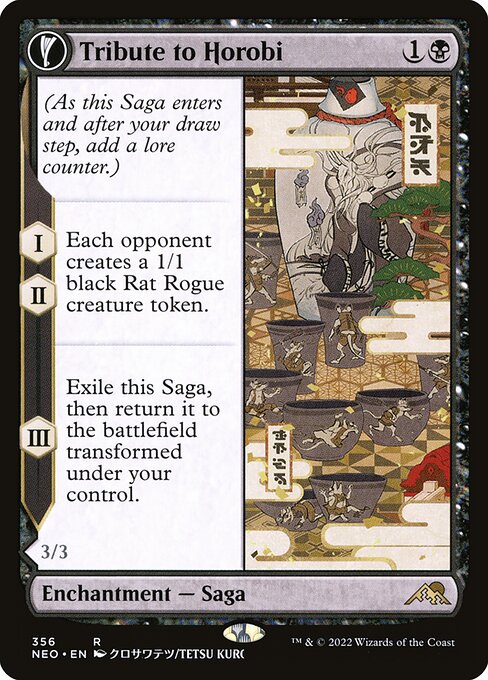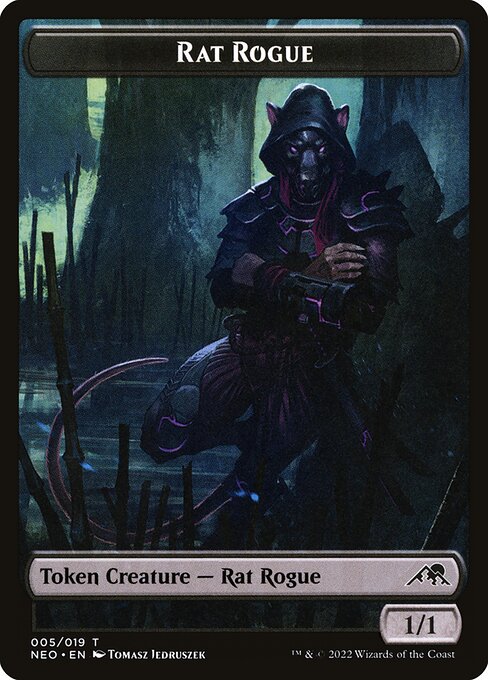Подношение Хороби // Эхо Смертного Воя
//
Чары — Сага // Чары Существо — Дух
(При выходе этой Саги и после вашего шага взятия карты добавьте один жетон знаний.)
I, II — Каждый оппонент создает одну фишку существа 1/1 черная Крыса Бродяга.
III — Изгоните эту Сагу, затем верните ее на поле битвы трансформированной под вашим контролем. // Полет, Ускорение
Когда Эхо Смертного Воя выходит на поле битвы, получите контроль над всеми фишками Крыс.
Каждый раз, когда Эхо Смертного Воя атакует, вы можете пожертвовать другое существо. Если вы это делаете, возьмите карту.
I, II — Каждый оппонент создает одну фишку существа 1/1 черная Крыса Бродяга.
III — Изгоните эту Сагу, затем верните ее на поле битвы трансформированной под вашим контролем. // Полет, Ускорение
Когда Эхо Смертного Воя выходит на поле битвы, получите контроль над всеми фишками Крыс.
Каждый раз, когда Эхо Смертного Воя атакует, вы можете пожертвовать другое существо. Если вы это делаете, возьмите карту.
3/3
standard
future
historic
gladiator
pioneer
modern
legacy
pauper
vintage
penny
commander
brawl
alchemy
paupercommander
duel
oldschool
premodern
Rulings
Each face of a transforming double-faced card has its own set of characteristics: name, types, subtypes, abilities, and so on. While a transforming double-faced permanent is on the battlefield, consider only the characteristics of the face that's currently up. The other set of characteristics is ignored.
A transforming double-faced card enters the battlefield with its front face up by default, unless a spell or ability instructs you to put it onto the battlefield transformed or you cast it transformed, in which case it enters with its back face up.
The back face of a transforming double-faced card usually has a color indicator that defines its color.
The mana value of a transforming double-faced card is the mana value of its front face, no matter which face is up.
Each transforming double-faced card in this set is cast face up. In every zone other than the battlefield, consider only the characteristics of its front face. If it is on the battlefield, consider only the characteristics of the face that's up; the other face's characteristics are ignored.
If you are instructed to put a card that isn't a double-faced card onto the battlefield transformed, it will not enter the battlefield at all. In that case, it stays in the zone it was previously in. For example, if a single-faced card is a copy of Azusa's Many Journeys, the chapter III ability will cause it to be exiled and then remain in exile.
A transforming double-faced card enters the battlefield with its front face up by default, unless a spell or ability instructs you to put it onto the battlefield transformed or you cast it transformed, in which case it enters with its back face up.
The back face of a transforming double-faced card usually has a color indicator that defines its color.
The mana value of a transforming double-faced card is the mana value of its front face, no matter which face is up.
Each transforming double-faced card in this set is cast face up. In every zone other than the battlefield, consider only the characteristics of its front face. If it is on the battlefield, consider only the characteristics of the face that's up; the other face's characteristics are ignored.
If you are instructed to put a card that isn't a double-faced card onto the battlefield transformed, it will not enter the battlefield at all. In that case, it stays in the zone it was previously in. For example, if a single-faced card is a copy of Azusa's Many Journeys, the chapter III ability will cause it to be exiled and then remain in exile.
Rulings
Each face of a transforming double-faced card has its own set of characteristics: name, types, subtypes, abilities, and so on. While a transforming double-faced permanent is on the battlefield, consider only the characteristics of the face that's currently up. The other set of characteristics is ignored.
A transforming double-faced card enters the battlefield with its front face up by default, unless a spell or ability instructs you to put it onto the battlefield transformed or you cast it transformed, in which case it enters with its back face up.
The back face of a transforming double-faced card usually has a color indicator that defines its color.
The mana value of a transforming double-faced card is the mana value of its front face, no matter which face is up.
Each transforming double-faced card in this set is cast face up. In every zone other than the battlefield, consider only the characteristics of its front face. If it is on the battlefield, consider only the characteristics of the face that's up; the other face's characteristics are ignored.
If you are instructed to put a card that isn't a double-faced card onto the battlefield transformed, it will not enter the battlefield at all. In that case, it stays in the zone it was previously in. For example, if a single-faced card is a copy of Azusa's Many Journeys, the chapter III ability will cause it to be exiled and then remain in exile.
A transforming double-faced card enters the battlefield with its front face up by default, unless a spell or ability instructs you to put it onto the battlefield transformed or you cast it transformed, in which case it enters with its back face up.
The back face of a transforming double-faced card usually has a color indicator that defines its color.
The mana value of a transforming double-faced card is the mana value of its front face, no matter which face is up.
Each transforming double-faced card in this set is cast face up. In every zone other than the battlefield, consider only the characteristics of its front face. If it is on the battlefield, consider only the characteristics of the face that's up; the other face's characteristics are ignored.
If you are instructed to put a card that isn't a double-faced card onto the battlefield transformed, it will not enter the battlefield at all. In that case, it stays in the zone it was previously in. For example, if a single-faced card is a copy of Azusa's Many Journeys, the chapter III ability will cause it to be exiled and then remain in exile.
Your collection? Your decks?
Want to manage your collection and/or create decks?




 0.21€
0.21€
